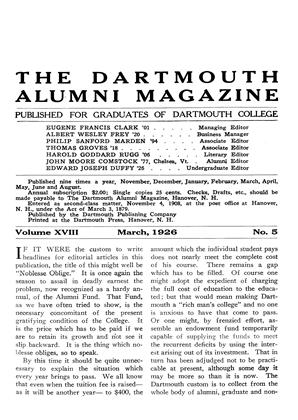Why is Dartmouth building a new library? Because Dartmouth men are using more books and room must be pro vided where these books can be kept and used. The nearest large libraries are a hundred and fifty miles away in Boston. A university, situated next door to the great public library of a city can get along with only a small library of its own; Dartmouth College, snowed up in the heart of the North Country, cannot.
The Committee on the Library has for several years, in its annual report to the Faculty, stated the facts relating to the growth of the collections and the rapidly increasing use of them, especially by the undergraduates. The more important of these facts are now presented as a part of the picture of life and work at Hanover which the ALUMNI MAGAZINE brings to the wider circle of Dartmouth men.
The library is growing. From twelve thousand five hundred volumes in 1830 it has increased to two hundred thirteen thousand in 1925. It grows, too, on Malthusian principles and for the last ninety-five years it has, with surprising regularity, doubled itself rather oftener than once in each twenty-five years. If this goes on the College will have half a million books in 1960 and a million in 1985.
Figure I
These facts are shown in Figure I. which scarcely needs further explanation.
The graph does not, however, tell all the facts. It shows that books are coming in but it does not show that of the two hundred thirteen thousand books belonging to the college in 1925 forty thousand are scattered about the campus in departmental libraries and thirty-four thousand are stored in the basements of dormitories whence they are obtainable only after much tribulation.
Now the college library is not a storage warehouse. Apparently the under- graduates of today do not intend that it shall become such. They are reading more books, more books per man, and more books of a serious character than at any time for the last twenty years.
The library staff cannot record all the activities of the library—that would take too much time from the service which is its main function to provide. Records are available, however, showing the number of books issued at the main delivery desk to undergraduates for use outside the library building. While these data do not show all the use that is made of the books, and are thus not comparable with the data from libraries which keep more complete records, they do show how that use varies from year to year at Dartmouth.
Figure 11.
Figure 11. tells the story. There was a period of comparative stagnation from 1904 to 1913 followed by an increase which was checked by the war and converted into a marked decrease. After the war the number of books issued rose from about 6,000 in 1918-1919 to 37,500 in 1924-25, and the number doubles it self in about four years. Since the wathe students are reading more fiction than ever before, but they are also reading fewer books of fiction than books not so classified and the percentage of fiction is decreasing. .
The college has grown since 1904. Vve should expect more books to be used by 2100 students than by 850. We find, however, that Dartmouth men are not only reading more books, but they are reading more books per man. Figure 111. shows this situation. There was a decline from 1904 to 1908, a period of stagnation from 1908 to 1912, then a rise checked and changed into a decline by the war. Finally from 1919 to 1925 the number of books per man rose from about five and one-half to seventeen and one-half. The number of books drawn per man, like the total circulation, doubles itself in about four years. The relation between fiction and non-fiction is essentially the same as in the case of the total issue.
The instruction in the college is to an increasing extent based on required reading in books reserved for the several courses. The library service which this requires is represented in relatively small part in the statistics just given. A recent cent canvass of the departments shows, however, that when ampler facilities are provided in a new building, this type of instruction will be used to a much greater extent. The sanguine, not to say sanguinary, estimates of the faculty indicate that it will then expect each stu-dent to spend about twelve hours a week in the library. If these estimates are realized the faculty will perhaps have approached the goal of the ideal physician—that of becoming superfluous.
Figure III.
Dartmouth College Library, Growth 1830-1925
Books issued to students for use outside the Library Building, College Year, Sept.-June, 1904-192 5
Books issued to students for use outside the Library Building, Volumes per student, College Year, Sept.-June, 1904-1925
Chairman of the Library Committee
 View Full Issue
View Full Issue
More From This Issue
-
 Article
ArticleWHAT'S THE MATTER WITH FOOTBALL?
March 1926 -
 Article
ArticleTHE BEGINNINGS OF ORGANIZED SKIING AT DARTMOUTH
March 1926 By Fred H. Harris '11 -
 Article
ArticleIF IT WERE the custom to write
March 1926 -
 Article
ArticleTHE UNDERGRADUATE CHAIR
March 1926 -
 Class Notes
Class NotesClass of 1918
March 1926 By Frederick W. Cassebeer -
 Class Notes
Class NotesClass of 1916
March 1926 By H. Clifford, Bean









